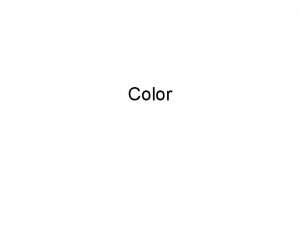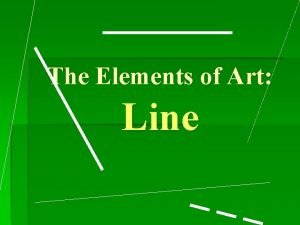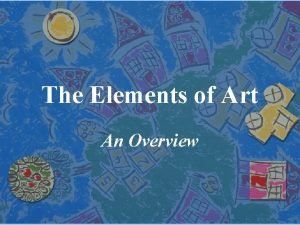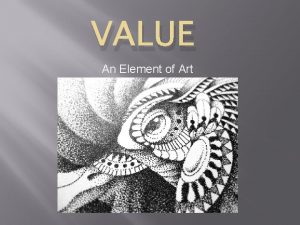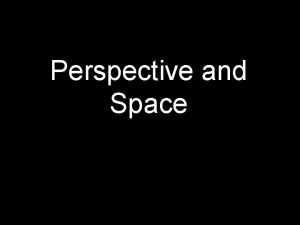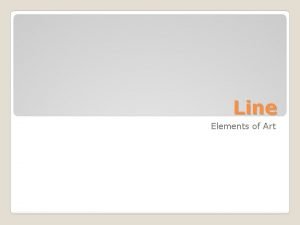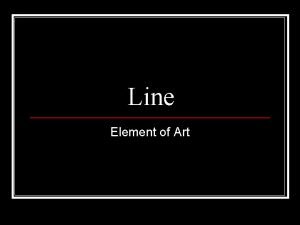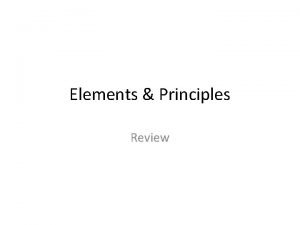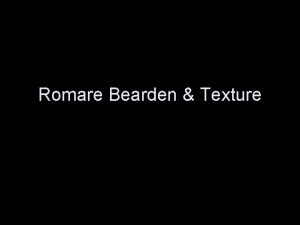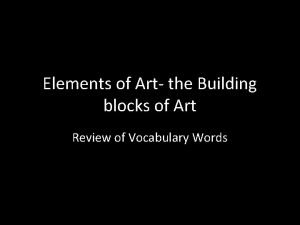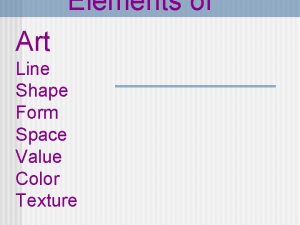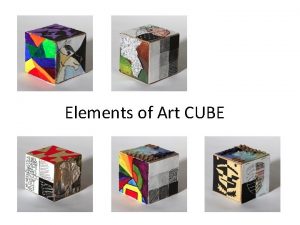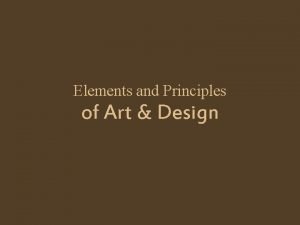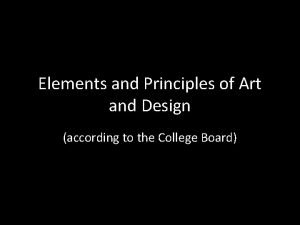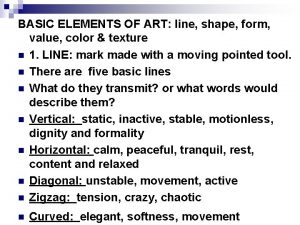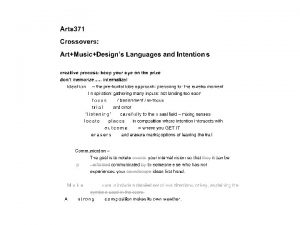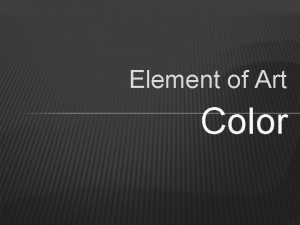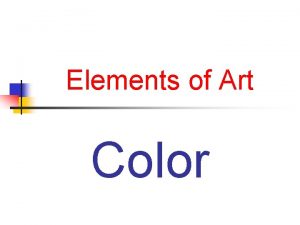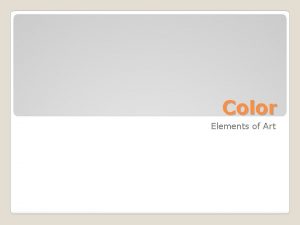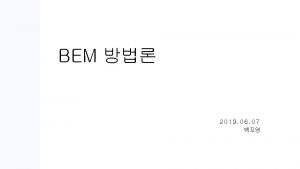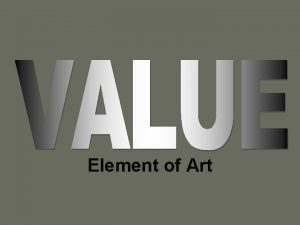COLOR Color is the element of art that










































- Slides: 42

COLOR ! Color is the element of art that is produced when light, striking an object, is reflected back to the eye.

THREE PROPERTIES OF COLOR Hue: The name given to a color (red, blue, etc. )

THREE PROPERTIES OF COLOR Intensity: The strength and vividness of a color

THREE PROPERTIES OF COLOR Value: The lightness or darkness of a color

ADDITIVE COLOR WHEEL Primary Red, Green, Blue Secondary Cyan, Yellow, Magenta * Televisions * Computer monitors

SUBTRACTIVE COLOR WHEEL Primary Cyan, Magenta, Yellow Secondary Red, Blue, Green * Printing * Photographs

THE COLOR WHEEL 12 Stage Color Wheel

PRIMARY COLORS In the RYB (or subtractive) color model, the primary colors are red, yellow and blue. Red Yellow Blue

SECONDARY COLORS The three secondary colors (orange, green and violet) are created by mixing two primary colors. Orange Green Violet

INTERMEDIATE/TERTIARY COLORS Another six intermediate or tertiary colors are created by mixing primary and secondary colors. Red-Orange Red-Violet Yellow-Green Yellow-Orange Blue-Green Blue-Violet

WARM AND COOL COLORS Warm Colors are associated with warm things such as sunshine or fire. They are vivid and energetic, and tend to advance in space. Cool Colors are associated with cool things such as ice, snow, water and grass. They give an impression of calm, and create a soothing impression.

TINTS, SHADES AND TONES Terms are often used incorrectly, although they describe fairly simple color concepts. Tints If a color is made lighter by adding white, the result is called a tint.

Shades If black is added, the darker version is called a shade.

Tones If the complement is added, the result is a tone.

MONOCHROMATIC COLORS Monochromatic color scheme means “One Color”. It is a color scheme that uses only one hue and all the values (tints and shades) of that hue.

COMPLEMENTARY COLORS These are colors that are opposite each other on the Color Wheel Red and green Yellow and violet Blue and orange

ANALOGOUS COLORS Analogous colors are colors that side by side on the Color Wheel and have a common hue.

SPLIT COMPLEMENTARY COLORS Split Complementary color scheme is a combination of one hue plus the hues on each side of it’s complement.

TRIADIC COLORS A triadic color scheme uses colors that are evenly spaced around the color wheel.

Triadic color schemes tend to be quite vibrant, even if you use pale or unsaturated versions of your hues. To use a triadic harmony successfully, the colors should be carefully balanced - let one color dominate and use the two others for accent.

COLOR You should have 8 definitions… now is time to add color. 1. 2. 3. 4. 5. 6. 7. 8. COLOR: definition & color wheel Primary, Secondary, Tertiary, Warm & Cool Tints, Shades, Tones Monochromatic Complementary Split-Complementary Analogous Triadic

ZENTANGLE COLORS What is a Zentangle? o o o Miniature pieces of unplanned, abstract art created in a very structured method from a series of repetitive patterns on a square paper tile. The process is a form of “artistic meditation” as one becomes completely engrossed in making each pattern, deliberately focusing on “one stroke at a time”. The creativity options and pattern combinations are boundless. And anyone can do it successfully!

ZENTANGLE HOW TO Create a Border o Using a pencil, draw a border around the square of paper, about a ¼” from the edge as shown. o Do it freehand let it be 'rough'.

ZENTANGLE HOW TO Draw a ‘String’ o Draw a light random line within the border o Can be anything but keep it simple. o Aim to create areas in which to doodle. o Experiment until you get something you are happy with.

ZENTANGLE HOW TO Fill Your Zentangle o Begin to fill the shapes made by your string. o While doing this you s can listen to some music. o These simple patterns you are creating are called 'tangles'.

ZENTANGLE HOW TO Keep going. Don't worry about patterns, as you do more, the next pattern seems to suggest itself. o You can work up to the border, however, you don't have to – leaving white space can work well too. o
















 Phân độ lown ngoại tâm thu
Phân độ lown ngoại tâm thu Block av độ 2
Block av độ 2 Thơ thất ngôn tứ tuyệt đường luật
Thơ thất ngôn tứ tuyệt đường luật Thơ thất ngôn tứ tuyệt đường luật
Thơ thất ngôn tứ tuyệt đường luật Walmart thất bại ở nhật
Walmart thất bại ở nhật Tìm độ lớn thật của tam giác abc
Tìm độ lớn thật của tam giác abc Con hãy đưa tay khi thấy người vấp ngã
Con hãy đưa tay khi thấy người vấp ngã Tôn thất thuyết là ai
Tôn thất thuyết là ai Gây tê cơ vuông thắt lưng
Gây tê cơ vuông thắt lưng Sau thất bại ở hồ điển triệt
Sau thất bại ở hồ điển triệt Most expressive element of art
Most expressive element of art Difference between signal element and data element
Difference between signal element and data element Signal element vs data element
Signal element vs data element The technique of using crossed lines for shading.
The technique of using crossed lines for shading. Value element of art photography
Value element of art photography 5 element of art
5 element of art Value art element
Value art element Space element of art
Space element of art Line element of art
Line element of art It is lines that change direction gradually
It is lines that change direction gradually Horizontal vertical e diagonal
Horizontal vertical e diagonal Element of art
Element of art Which element of art
Which element of art Line form shape and size
Line form shape and size Element of art cube
Element of art cube Element and principles of art
Element and principles of art It is about service quality either tactile or visual
It is about service quality either tactile or visual Shape form and value
Shape form and value Plane design element
Plane design element Elements and principles of art
Elements and principles of art Hình ảnh bộ gõ cơ thể búng tay
Hình ảnh bộ gõ cơ thể búng tay Slidetodoc
Slidetodoc Bổ thể
Bổ thể Tỉ lệ cơ thể trẻ em
Tỉ lệ cơ thể trẻ em Voi kéo gỗ như thế nào
Voi kéo gỗ như thế nào Tư thế worm breton là gì
Tư thế worm breton là gì Chúa sống lại
Chúa sống lại Các môn thể thao bắt đầu bằng tiếng chạy
Các môn thể thao bắt đầu bằng tiếng chạy Thế nào là hệ số cao nhất
Thế nào là hệ số cao nhất Các châu lục và đại dương trên thế giới
Các châu lục và đại dương trên thế giới Công thức tính thế năng
Công thức tính thế năng Trời xanh đây là của chúng ta thể thơ
Trời xanh đây là của chúng ta thể thơ Cách giải mật thư tọa độ
Cách giải mật thư tọa độ










